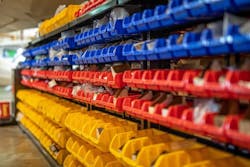Sept. 15, 2020—Shop owners work too hard to be duped by counterfeit parts, which not only pose a risk to drivers but can also cast an unwanted shadow over a shop’s reputation. As such fakes proliferate on the market, FenderBender spoke to an expert for tips on how to avoid counterfeit parts.
What are the risks?
Counterfeit parts may appear identical to authentic parts, but the ways in which they operate could be the difference between life and death. Wade Hilburn is the president and CEO of Original One Parts, an OE-certified parts distributor.
“Counterfeit lights, for example,” says Hilburn, “may not provide sufficient illumination for night driving required by regulatory authorities, and often corrode sooner.”
Insufficient illumination could lead to myriad problems, from driving off the road, to hitting a deer, to hitting another vehicle.
How do you spot a counterfeit part?
Hilburn says counterfeit parts are intentionally made to look as close to the real ones as possible.
“Often the brand name is made to look similar to the real brand,” he says. “By using the same packaging design, color, and font, to a person not looking closely, it looks very similar.”
While there is no foolproof way to spot a counterfeit part, there are a few tip-offs that technicians should be looking for.
Most OEMs, like Ford and General Motors, stamp each of their parts with a service number or engineering part number, says Hilburn. If the number is missing from your part, that could be a hint that it’s not the real deal.
Another hint is the weight of the part. Hilburn says oftentimes counterfeit parts will be lighter than certified ones. He says an experienced installer could know the difference just by picking up the fake.
How do you avoid using counterfeit parts?
In order to avoid counterfeit parts, Hilburn encourages shops to buy OEM parts from a reputable parts supplier.
“The best way to protect yourself is to use a reputable parts supplier that you can trust,” he says, “one with a good process to ensure that counterfeit parts cannot make their way into their inventory, for resale to you.”
His last piece of advice is timeless—be weary of the internet. Hilburn says to use extreme caution when buying online, where prices appear the lowest, especially if the part is being shipped from outside the United States. He says online is where Original One Parts sees a majority of counterfeit products. “If it seems too good to be true—it probably is.”
